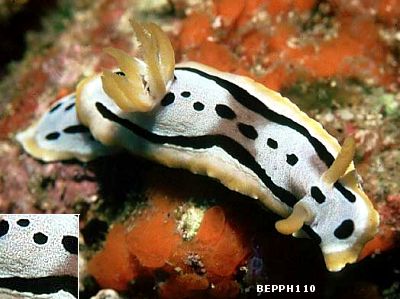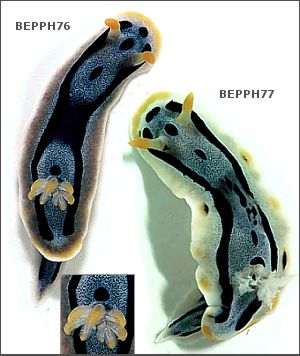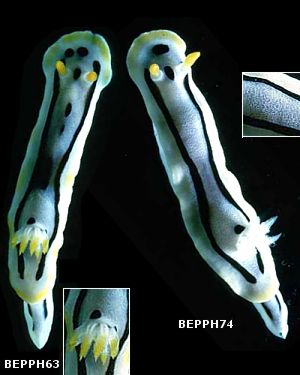Colour variation in Chromodoris michaeli
June 24, 2001
From: Bernard Picton

Hi Bill,
Here are scans of animals which I collected in 1983 in the Philippines. They seem to be Chromodoris michaeli Gosliner & Behrens, 1998.
These animals show that the submarginal orange band described by Gosliner & Behrens is not always continuous, but can be a series of spots or patches along the sides of the body and continuous at the front and back of the mantle. It is interesting to see that this species, in common with C. annae, C. westraliensis and C. strigata shows a 'saddle' of darker pigment in the middle of the back - is this due to relationship (DNA) or selection mimicry/signalling)?
BEPPH110 - Apo Island, Negros - 1 APR 1983, 5cm.
BEPPH77 - Dumaguete, Negros - 30 MAR 1983
BEPPH76 - Dumaguete, Negros - 30 MAR 1983
BEPPH63 - Mactan Is., Cebu - 27 MAR 1983
BEPPH74 - Dumaguete, Negros - 30 MAR 1983 -
Bernard
bernard.picton.um@nics.gov.uk


Dear Bernard,
After posting Erwin's message last night I remembered I had put this message of yours to one side until I had time to arrange the wonderful images together. If all these are the same species, then I guess Erwin's earlier photo is also of C. michaeli.
I looked at the anatomy of these specimens when you sent them to me from the Philippines 15 years ago. The reason I did not name them myself is that I could not match the colour patterns with good anatomical differences and so could not decide where to draw the line between species. I still can't. My biggest problem is with the gill colouration. In other groups of similarly coloured species, the detail of the colour pattern on the gills and rhinophores has been consistent and often species specific. In your photos BEPPH110 has translucent orange gills, which I suspect is a variant of gills with just an orange band up the outer edge as in Erwin's photo. BEPPH63 & BEPPH76 appear to have the whole of the upper half of each gill translucent orange, and BEPPH74 & BEPPH77 have colourless gills. If we add to this, the two colour forms found in Chromodoris dianae I still find the situation puzzling.
Thanks for these photos,
Best wishes,
Bill Rudman
Related messages
-
Chromodoris michaeli from Ningaloo Reef, W Australia
From: Kristin J Anderson, February 6, 2008 -
Chromodoris michaeli from Sulawesi
From: David Thompson, May 15, 2003 -
Re: Chromodoris michaeli? from the Philippines
From: Dave Behrens, December 5, 2002 -
Chromodoris michaeli? from the Philippines
From: Erwin Koehler, December 4, 2002 -
Chromodoris from Ashmore Reef
From: Richard Willan, July 13, 2001 -
Re: Colour variation in Chromodoris michaeli
From: Erwin Koehler, July 5, 2001 -
Chromodoris michaeli from Okinawa
From: Bob Bolland, June 24, 2001 -
Re: Chromodoris michaeli? from the Philippines
From: Erwin Koehler, June 23, 2001
